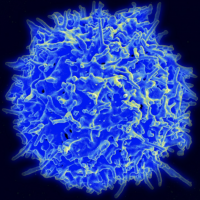False neg PET scan
Hi,
I am new to this forum and really appreicate any feed back. I am a 36y/o male. I have had labs and biopsies that all say consitent for T-cell lymphoma. I have double neg cd4/8 plus loss of expression of cd5 and partial loss of 7. I have a m-spike with monoclonal dectected.. I had a endoscope which found a 4 by 3 cm lymph noode, which was biopsied and came back postive and a bone marrow biospy as well. I then had a PET scan which came back negative. I have all these labs and reports saying its perhperial T-cell lymphoma, but then a negative PET. How can this be.
Comments
-
One thought
Just taking a stab at this, but it really is a conversation to have with your oncologist (preferably hemato-oncologist) and radiologist.
Here goes: PET scans "work" by detecting the uptake of a radioactive sugar (FDG) relative to background tissue uptake. (Note: this is why you starve yourself of sugar for 24 hrs before the PET). Uptake is a reflection of metabolic activity and/or cell division. So a rapidly dividing, highly metabolically active cell (i.e., an aggressive tumor) will glow relative to background. But not all tumors are rapidly dividing/highly metabolically active. So, one possibility is that you have a T-cell lymphoma that is a slow-grower. Has anyone used the word "indolent" when describing your results/diagnosis?
We have some major T-lymphoma experts here who should be able to shed more light on this apparent conundrum. But my understanding of the methods (biopsy & PET) and quick perusal of the literature suggest to me that this happens. Best of luck going forward.
0 -
Starve yourself of sugar 24 hours prior to PET?Evarista said:One thought
Just taking a stab at this, but it really is a conversation to have with your oncologist (preferably hemato-oncologist) and radiologist.
Here goes: PET scans "work" by detecting the uptake of a radioactive sugar (FDG) relative to background tissue uptake. (Note: this is why you starve yourself of sugar for 24 hrs before the PET). Uptake is a reflection of metabolic activity and/or cell division. So a rapidly dividing, highly metabolically active cell (i.e., an aggressive tumor) will glow relative to background. But not all tumors are rapidly dividing/highly metabolically active. So, one possibility is that you have a T-cell lymphoma that is a slow-grower. Has anyone used the word "indolent" when describing your results/diagnosis?
We have some major T-lymphoma experts here who should be able to shed more light on this apparent conundrum. But my understanding of the methods (biopsy & PET) and quick perusal of the literature suggest to me that this happens. Best of luck going forward.
I’ve never had to do that and I’ve had 10+ PET scans in the last 5 years. I’ve lost count. I wonder why you have to do that and I don’t.
0 -
Knowing the sub-type will greatly help
T-Cell Lymphomas are all over the map. Skin lymphomas are a nuisance. Most systemic T-Cell Lymphomas are a near term emergency - no such thing as W&W. Some systemic T-Cell Lymphomas, for genetic reasons, take a more indolent course. Knowing the sub-type can be crucial.
0 -
Not all the samegbread said:Starve yourself of sugar 24 hours prior to PET?
I’ve never had to do that and I’ve had 10+ PET scans in the last 5 years. I’ve lost count. I wonder why you have to do that and I don’t.
There are different methods to PET's...Not all use the FDG sugar tracer; there are others. Also, I think that there is some variation in the sugar restriction requirement, depending on the machine, the radiologist, etc. My clinic uses something akin to this, but others may be less stringent: https://www.cedars-sinai.edu/Patients/Programs-and-Services/Imaging-Center/For-Patients/Preparing-for-Your-Exam/PET-Scan-Preparation/
0 -
PETs are useful for staging
Sorry to hear of this. First, T-Cell Lymphomas are some of the (if not the most) most widely diversified tumor cells that exist. As science delves more deeply into genomic profiling, it is found that of the 24-26 or so sub-types of T-Cell Lymphoma, there are huge variations, with some types persuing a more indolent course while most all of them remain strictly aggressive. There are 4 known sub-types of Angioimmunoblastic T-Cell Lymphoma, for example. This explains why some seemingly sit around (Low Ki67 rate, low SUV) while most others are rocketing ahead at full speed. A more indolent type would show a low SUV - which while not exactly a false negative, is misleading.
Bear in mind that a PET is not all that precise of a tool. Your brain and liver have a fairly serious SUV, but are not cancerous. Was contrast used (EDIT) if a CT was performed? That may make the difference. And, I would hope that the node is sent off for genomic profiling, as it can make a huge difference in treatent and outcome.
0 -
Is it not a "fast"?Evarista said:Not all the same
There are different methods to PET's...Not all use the FDG sugar tracer; there are others. Also, I think that there is some variation in the sugar restriction requirement, depending on the machine, the radiologist, etc. My clinic uses something akin to this, but others may be less stringent: https://www.cedars-sinai.edu/Patients/Programs-and-Services/Imaging-Center/For-Patients/Preparing-for-Your-Exam/PET-Scan-Preparation/
Carbs convert to blood sugar, so as I recall, it is a general fast - something like 8 hours prior to the PET.
0 -
po18guy said:
Is it not a "fast"?
Carbs convert to blood sugar, so as I recall, it is a general fast - something like 8 hours prior to the PET.
Yes, Po, all the instructions I've seen require restricted food intake ("fast") for at least 4+ hours prior to the scan. There seems to be variation on the carbohydrate intake rules, so I just do what my clinic instructs. Diabetics have their own guidelines. My clinic will not do a PET if blood sugar is over 200. We are also advisted to not engage in strenous exercies for the 24 hrs prior to the scan, presumably because low grade tissue repair/recovery/inflammation gives a higher background. I think everybody needs to follow their own clinic's guidelines, of course.
0 -
PETEvarista said:Yes, Po, all the instructions I've seen require restricted food intake ("fast") for at least 4+ hours prior to the scan. There seems to be variation on the carbohydrate intake rules, so I just do what my clinic instructs. Diabetics have their own guidelines. My clinic will not do a PET if blood sugar is over 200. We are also advisted to not engage in strenous exercies for the 24 hrs prior to the scan, presumably because low grade tissue repair/recovery/inflammation gives a higher background. I think everybody needs to follow their own clinic's guidelines, of course.
my instructions were nothing to eat after 10 PM the night before the scan.
0 -
Fast for PETSEvarista said:Yes, Po, all the instructions I've seen require restricted food intake ("fast") for at least 4+ hours prior to the scan. There seems to be variation on the carbohydrate intake rules, so I just do what my clinic instructs. Diabetics have their own guidelines. My clinic will not do a PET if blood sugar is over 200. We are also advisted to not engage in strenous exercies for the 24 hrs prior to the scan, presumably because low grade tissue repair/recovery/inflammation gives a higher background. I think everybody needs to follow their own clinic's guidelines, of course.
My scans have always stated to eat only vegetables and protein the day before, no sugar, and only water after mid-night. I remember that that was always my excuse to have a big steak with salad and no dressing the night before. The hospital is only one mile from my home and they told me I was not to walk to the hospital, and no exercise the day before. I think the difference between centers eating requirements is one of the reasons doctors don't want you to change locations were the scans are done.
0 -
Indeed!Evarista said:Yes, Po, all the instructions I've seen require restricted food intake ("fast") for at least 4+ hours prior to the scan. There seems to be variation on the carbohydrate intake rules, so I just do what my clinic instructs. Diabetics have their own guidelines. My clinic will not do a PET if blood sugar is over 200. We are also advisted to not engage in strenous exercies for the 24 hrs prior to the scan, presumably because low grade tissue repair/recovery/inflammation gives a higher background. I think everybody needs to follow their own clinic's guidelines, of course.
In aggressive lymphomas, it is not as critical, but to ferret out the indolent types, low sugar is best. Now that I'm also diabetic, I'll have to shoot up before he next PET - which hopefully will not occur due to the transplant. If the GvL effect is anything like the GvHD, I'm done with lymphoma, CTs and PETs. The downside? GvHD is the new cancer. Oh well, one must be alive to have complaints.
0
Discussion Boards
- All Discussion Boards
- 6 CSN Information
- 6 Welcome to CSN
- 122K Cancer specific
- 2.8K Anal Cancer
- 446 Bladder Cancer
- 309 Bone Cancers
- 1.6K Brain Cancer
- 28.5K Breast Cancer
- 398 Childhood Cancers
- 27.9K Colorectal Cancer
- 4.6K Esophageal Cancer
- 1.2K Gynecological Cancers (other than ovarian and uterine)
- 13K Head and Neck Cancer
- 6.4K Kidney Cancer
- 673 Leukemia
- 794 Liver Cancer
- 4.1K Lung Cancer
- 5.1K Lymphoma (Hodgkin and Non-Hodgkin)
- 238 Multiple Myeloma
- 7.2K Ovarian Cancer
- 63 Pancreatic Cancer
- 487 Peritoneal Cancer
- 5.5K Prostate Cancer
- 1.2K Rare and Other Cancers
- 543 Sarcoma
- 736 Skin Cancer
- 657 Stomach Cancer
- 192 Testicular Cancer
- 1.5K Thyroid Cancer
- 5.9K Uterine/Endometrial Cancer
- 6.3K Lifestyle Discussion Boards



